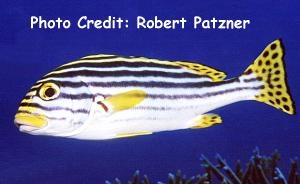
By Bob Goemans

Not Reef Tank Suitable
Likely Fish-Only Tank Suitable
Range: Indo-West Pacific Ocean: East Africa to Samoa, north to Southern Japan, and south to New Caledonia.
Size: 34 inches (84 cm)
Natural Environment: Inhabits reef channels and outer-reef faces and slopes and spends the daytime in caves and under ledges at depths between 6 to 150 feet (2 – 45 m) and feeds at night on shrimp, crabs, snails, worms and various other benthic invertebrates and small fishes.
General Husbandry: Occasionally seen in the trade, with the juvenile having a black and white body and the adult a whitish body with black horizontal lines and black spots on the yellow dorsal, anal, pelvic and tail fins.
Requires a very large fish-only aquarium with wide-open swimming areas and areas/caves to take shelter during daytime hours As to diet, newcomers are sometimes shy and difficult to get feeding, therefore require fortified live brine shrimp and/or live glass/grass shrimp to get feeding. Once accepting aquarium foods, a wide variety of frozen and fresh meaty foodstuffs (chopped squid, fish flesh, scallops, shrimp, clam, etc.) can be offered and fed several times daily. Any ornamental crustaceans and small fish in the aquarium will also be consumed.
Taxonomy:
Order: Perciformes
Suborder: Percoidei
Family: Lutjanidae
Genus: Plectorhinchus
FYI: Usually seen as juveniles in the trade, however, they grow fast and soon outgrow most hobbyist aquariums.
May stir up the substrate looking for food.
Experience Level: Intermediate
Temperament: Peaceful
Diet: Carnivore
Coral Safe: Yes
Invertebrate Safe: No
Fish Safe: With caution
Acclimation Time: 30 minutes+
Aquarium Environment: Fish-only aquarium
Tankmates: Peaceful or non-aggressive
Minimum Tank Size: 300 gallons
Temperature Range: 72 - 82°F (22 – 28°C)
Specific Gravity: 1.020 -1.026
pH: 8.0 - 8.5
 (BF).jpg)
